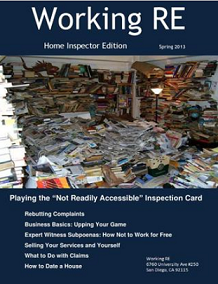 |
>> See Past News Editions >> Follow our NEW Home Inspector RSS Feed >> Click to Print > > Shop E&O: Click Now! |
Special Offer: Working RE is excited to announce the launch of a new print magazine exclusively for home inspectors. The premier issue mails January 2016. For a limited time, you can reserve a free subscription here.
Don’t Overlook the Smoke Alarms and CO Alarms
By Rick Bunzel, ACI
We all deal with managing liability in our business lives. Home inspectors and appraisers call out health and safety issues all the time. In Washington state appraisers are now supposed to call out missing carbon monoxide (CO) detectors. One way to manage our liability is to ensure that homes have working safety equipment. While I understand that our role is not to enforce building codes, I do see it as ensuring that the safety equipment is present and in reasonable order.
One area I see frequently overlooked is not calling out old, missing or disconnected smoke detectors. In 2014, the US had 3,275 civilian fire deaths (NFPA Report). Many of these deaths could have been prevented by having working smoke detectors. If a fire death occurs in a home recently inspected by one of us, do you think it is possible that we would get drawn into a wrongful death suit?
In many older homes there will only be a single smoke detector installed in a hallway. The National Fire Protection Association (NFPA) recommends that there should be at least one smoke detector on each level of a home, including the basement and walk-in attic. There should be a smoke detector in every bedroom and outside each sleeping area. Smoke detectors are not to be installed in kitchens and adjacent to bathrooms. Those locations will cause false alarms and in my experience the occupants will usually disable the alarm.
The life expectancy of smoke alarms is generally 10 years, after which their sensors can begin to lose sensitivity. The test button only confirms that the battery, electronics, and alert system are working; it doesn’t mean that the smoke sensor is working. The only way to test that is with “canned smoke.” In my experience the easiest and quickest way to gauge the age is by looking at the detector color. The detector shell is no longer white and turned golden beige, most likely it’s older than 10. If the detector is white but the home is in the 10 to 15 year range, then most likely the detectors are original and should be changed. Many units will have a date on the unit label. This requires removing the unit to take a look. Almost all smoke alarms can be removed with a half turn.
(story continues below)
(story continues)
The most common smoke alarm type, ionization alarms, are generally more responsive to a flaming fire, for instance, when a lit candle tips over and ignites a drape- according to Underwriters Laboratories (UL). These alarms use electrically charged particles, to detect smoke in the air. UL says that, because they are inexpensive, ionization detectors are the most commonly found smoke alarms in homes in the US.
The second type of detector is the photoelectric smoke alarm, which uses a light beam to detect the presence of smoke. According to UL, these alarm types are more effective at sounding when a fire originates from a smoldering source, like a smoldering couch cushion. Smoldering fires can fill a home with dangerous gases before a fire ever erupts.
In recent years there has been controversy over which type of smoke alarm is superior but tests have proven both types have their strengths and it’s impossible to predict what type of fire a home will have. Recently, the following organizations recommend having both ionization and photoelectric detectors in a home to maximize protection: National Fire Protection Association (NFPA), U.S. Fire Administration (USFA), National Institute of Standards and Technology (NIST), Consumer Products Safety Commission (CPSC), National Association of State Fire Marshals (NASFM) and Underwriters Laboratories (UL). Fortunately the costs of dual sensor alarms have dropped to where they are only slightly more expensive than single sensor alarms.
In the U.S. there is an average of 430 Carbon Monoxide deaths annually according to the Centers for Disease Control and Prevention (CDC). Many more people are sickened but survive. All homes should also have one or more carbon monoxide (CO) alarms in them. In Washington and other states, the law requires that a home should have a CO detector on each habitable level. The CO detector can be installed high or low on a wall or combined with a smoke alarm. Most CO alarm sensors wear out in five-seven years and should be replaced. CO alarms manufactured after 2009 have technology that will alert you when the sensor wears out, however many of the units I see were manufactured prior to that and owners are still using them. All CO alarms are dated so it’s easy to establish its age.
Working smoke and CO alarms save lives. By taking a few steps in our appraisal or home inspection we can ensure that this important safety equipment will be ready in an emergency.
Special Offer: Working RE is excited to announce the launch of a new print magazine exclusively for home inspectors. The premier issue mails January 2016. For a limited time, you can reserve a free subscription here.
About the Author
Rick Bunzel is the principal inspector with Pacific Crest Inspections and an ASHI Certified Inspector #249557. He holds a BA in Business Marketing. He is past Chair of the Marketing and Public Relations Committees for a national home inspection organization. Locally, he Chairs the North Puget Sound Board of Realtor’s Communications Committee and is a firefighter/ EMT with the Mt. Erie Fire Department in Anacortes, WA.


